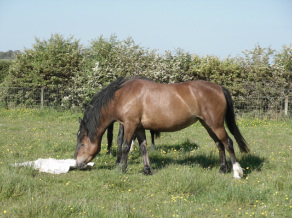Teaching Empathic Horsemanship Based On Classical Principles.
About me:

I have owned, ridden and worked with horses for over 50 years.
I have studied the Alexander Technique since 1982.
The Alexander Technique is a discipline which teaches a way of helping the mind and body to work together in the most efficient way. Through increased awareness of balance and good posture the student learns to release tension and develops the means whereby good use and posture can be maintained. It provides long term benefits by reducing wear and tear on joints and soft tissues, and allows the student to identify and correct problems as they arise. Many of the principles of Centered Riding are based on Alexander Technique training.
(www.stat.org.uk; www.alexandertechnique.com)
I have a Master's degree (M.Sc 2006) in Equine Science from the Royal (Dick) School of Veterinary Studies at the University of
Edinburgh.
This unique course delivered a thorough and detailed grounding in all aspects of equine biology;
because of its unique position within a veterinary school there was a strong emphasis on athletic performance, injury and disease, and on
current research into complex conditions such as tendon injury, grass sickness
and laminitis.
Combined with my experience of handling and working with horses, the knowledge gained from this course enables me to be clear about the horse's physical, behavioural or emotional response to input from the rider. I am also able to assess the influence of factors such as saddle and bridle fit, environment, feeding, shoeing and general fitness.
I hold the Stage 3 (Groom's) Certificate of the British Horse Society. (www.bhs.org.uk)
I have been a certified Centered Riding Instructor since 2008, and I achieved an upgrade to Level II in June 2014. In addition to continuous CPD, Centered Riding Instructors are required to complete a 4 day Update every 2-3 years. During this the Instructor's riding, teaching and understanding of body awareness is assessed and re-certified.
(www.centeredriding.org)
I regularly practice the Chinese movement art of Qi Gong with my own teacher and through Shi Heng Yi of Shaolin Temple Europe (www.shihengyi.online/).
I am committed to continually studying and developing my horsemanship, and in addition to Centered Riding I have attended clinics with Mark Rashid, Buck Brannaman and Steve Halfpenny, travelled to Vienna for seminars at the Spanish Riding School, and taken part in courses about Equine Behaviour and Learning. Online facilities have allowed me to access high quality information and discussion relating to human and equine neuroscience, an aspect of my work with horses and riders which is growing in significance just now. I believe that there is never one way above all others of working with horses, it’s much more about understanding the horse, how we ourselves are, and how we relate to and understand what it is we’re trying to achieve.
For more details about Centered Riding® or Empathic Horsemanship lessons click here.
I have studied the Alexander Technique since 1982.
The Alexander Technique is a discipline which teaches a way of helping the mind and body to work together in the most efficient way. Through increased awareness of balance and good posture the student learns to release tension and develops the means whereby good use and posture can be maintained. It provides long term benefits by reducing wear and tear on joints and soft tissues, and allows the student to identify and correct problems as they arise. Many of the principles of Centered Riding are based on Alexander Technique training.
(www.stat.org.uk; www.alexandertechnique.com)
I have a Master's degree (M.Sc 2006) in Equine Science from the Royal (Dick) School of Veterinary Studies at the University of
Edinburgh.
This unique course delivered a thorough and detailed grounding in all aspects of equine biology;
because of its unique position within a veterinary school there was a strong emphasis on athletic performance, injury and disease, and on
current research into complex conditions such as tendon injury, grass sickness
and laminitis.
Combined with my experience of handling and working with horses, the knowledge gained from this course enables me to be clear about the horse's physical, behavioural or emotional response to input from the rider. I am also able to assess the influence of factors such as saddle and bridle fit, environment, feeding, shoeing and general fitness.
I hold the Stage 3 (Groom's) Certificate of the British Horse Society. (www.bhs.org.uk)
I have been a certified Centered Riding Instructor since 2008, and I achieved an upgrade to Level II in June 2014. In addition to continuous CPD, Centered Riding Instructors are required to complete a 4 day Update every 2-3 years. During this the Instructor's riding, teaching and understanding of body awareness is assessed and re-certified.
(www.centeredriding.org)
I regularly practice the Chinese movement art of Qi Gong with my own teacher and through Shi Heng Yi of Shaolin Temple Europe (www.shihengyi.online/).
I am committed to continually studying and developing my horsemanship, and in addition to Centered Riding I have attended clinics with Mark Rashid, Buck Brannaman and Steve Halfpenny, travelled to Vienna for seminars at the Spanish Riding School, and taken part in courses about Equine Behaviour and Learning. Online facilities have allowed me to access high quality information and discussion relating to human and equine neuroscience, an aspect of my work with horses and riders which is growing in significance just now. I believe that there is never one way above all others of working with horses, it’s much more about understanding the horse, how we ourselves are, and how we relate to and understand what it is we’re trying to achieve.
For more details about Centered Riding® or Empathic Horsemanship lessons click here.